 |
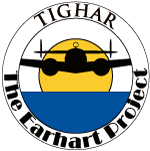

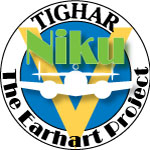
The Niku V Plan
The Niku V expedition – our eighth to Nikumaroro and our ninth to the Phoenix Group – will focus on the two established archaeological sites which have yielded artifacts believed to be associated with the Earhart disappearance – the old village and the castaway’s campsite. This expedition will further excavate, examine and expand those sites. The Old Village The B-24 parts appear to be explainable. No aircraft crashed or was damaged at Nikumaroro during WWII or afterward. Kanton Island, two hundred miles away, was the site of a large and active U.S. military airfield during the war and at least one B-24 is known to have crashed there. In the 1950s, Kanton (then spelled Canton) became an important refueling stop for British and American trans-pacific commercial flights and people from Nikumaroro were employed there. The B-24 parts were probably imported to Nikumaroro in the post-war years by returning workers. The aircraft parts that do not fit any known WWII type and appear to be consistent with Earhart’s Electra are harder to explain unless they did, in fact, come from Earhart’s airplane. There is a tradition among the people who formerly lived on the island that there was aircraft wreckage on the western reef when the first settlers arrived in 1939. The larger pieces of wreckage are probably now in the very deep water off the edge of the reef. Searching that environment is beyond the scope and financial resources of this expedition, but our hope is that the village will yield more aircraft debris that will be sufficiently identifiable to justify the expense of a deep water search. The Seven Site Only five teeth were present when the skull and mandible were recovered in 1940, so it would seem that twenty-three teeth (not counting four wisdom teeth which may or may not have been present) came loose and fell out before the partial skeleton was discovered. Only thirteen relatively large bones, of the three hundred fifty bones in the human body, were found in 1940. The bones that were missing are believed to have been carried off by giant Coconut Crabs (Birgus latro). Some of the missing bones and teeth may still survive and could, if recovered, yield DNA for matching against Earhart’s living relatives. Finding them among the dense tropical vegetation and coral rubble will be a daunting task. Special Investigations In addition to the archaeological work, we’ll be carrying out three special investigations during Niku V. The bones that were missing from the partial skeleton found in 1940 were presumably carried off by giant coconut crabs (Birgus latro). To conduct an efficient search for those bones, if they still exist, we need to know where to look. During the 2001 expedition, our forensic anthropologist, Dr. Karen Burns, laid out a lamb shoulder on Nikumaroro and documented its deterioration with twice-daily visits to the site. The entire subject – roughly five pounds of flesh and bones – disappeared in the course of five days. Coconut crabs were observed at the site on several occasions, as well as numerous smaller strawberry land hermit crabs (Coenobita perlatus). What is not known, and is apparently unknown to the scientific community at large, is exactly what coconut crabs do with bones when they carry them away. Do they take them down into their burrows? Do they carry them for some distance and then drop them? Do they consume them bit by bit? No one knows. Before our departure from Fiji, Dr. Burns will obtain the bones of a pig. Our team physician, Dr. Robin Acker will help verify that no pathogens are present, as we want to be very sure not to contaminate the island environment. The bones will be frozen and transported to Nikumaroro in a frozen state. Upon arrival, Drs. Burns and Acker will install metal screws in the bones so that they can be found using a metal detector and also attach long, brightly-colored “tails” to make the bones easier to find visually. The bones will be laid out on Nikumaroro and the crabs will, presumably, after some period of time, take them away. Cameras set to take photos automatically at set intervals should give us information about what bones are taken by which crabs. We’ll then try to relocate the bones to learn where the crabs go with them and what they do with them. We’ll use that information to design a search for any surviving castaway bones. Reef/Tidal Survey The Sokkia company, through Instrument Sales & Service of Wilmington, DE, has equipped us with two SRX Robotic Total Station surveying systems. In addition to documenting the archaeological work, we’ll be using this very sophisticated surveying equipment to collect information about the reef-flat where it appears the Electra was landed on July 2, 1937 and subsequently washed over the reef edge. We’ll also be collecting current tidal information to verify and/or correct our calculations of tidal condition on the reef in 1937. “Arrowhead” Investigation |
TIGHAR is a 501(c)(3) public charity. All contributions are tax deductible to the full extent of the law.
The answers to the Earhart riddle are on Nikumaroro. If you would like to help sponsor the 70th Anniversary Expedition please contact Ric Gillespie at (610) 467-1937 or by email.
 |
Copyright 2021 by TIGHAR, a non-profit foundation. No portion of the TIGHAR Website may be reproduced by xerographic, photographic, digital or any other means for any purpose. No portion of the TIGHAR Website may be stored in a retrieval system, copied, transmitted or transferred in any form or by any means, whether electronic, mechanical, digital, photographic, magnetic or otherwise, for any purpose without the express, written permission of TIGHAR. All rights reserved. Contact us at: info@tighar.org • Phone: 610.467.1937 • JOIN NOW |
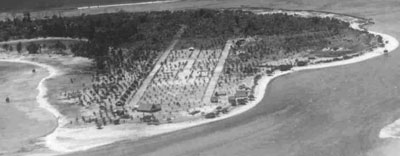 Our quest for airplane-related artifacts will focus on
the portion of the abandoned settlement at the atoll’s western end where we have found
aircraft debris on previous expeditions. We know that the Pacific islanders
who lived there from 1939 to 1963 cut up sheet aluminum and plexiglas salvaged
from aircraft wrecks for local use – primarily for making fishing
lures and decorative objects. Our previous archaeological excavations
in the village have produced left over scraps from that activity. The
aircraft artifacts found to date fall into three categories; components
from a WWII Consolidated B-24, components that do not fit any known WWII
type and appear to be consistent with Earhart’s Electra; scraps that are too small
or generic to attribute to any particular aircraft.
Our quest for airplane-related artifacts will focus on
the portion of the abandoned settlement at the atoll’s western end where we have found
aircraft debris on previous expeditions. We know that the Pacific islanders
who lived there from 1939 to 1963 cut up sheet aluminum and plexiglas salvaged
from aircraft wrecks for local use – primarily for making fishing
lures and decorative objects. Our previous archaeological excavations
in the village have produced left over scraps from that activity. The
aircraft artifacts found to date fall into three categories; components
from a WWII Consolidated B-24, components that do not fit any known WWII
type and appear to be consistent with Earhart’s Electra; scraps that are too small
or generic to attribute to any particular aircraft.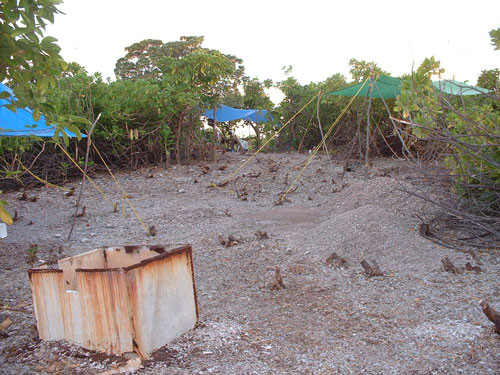 Our search for human remains and/or personal effects will
be concentrated on the area near the atoll’s southeastern tip where the campsite
and partial skeleton of a castaway were found in 1940. Known to us as the “Seven
Site,” from a large natural bare spot in the vegetation in the shape
of a numeral seven, the location was confirmed by our 2001 expedition to
match the description of where the partial skeleton was found in 1940.
Our search for human remains and/or personal effects will
be concentrated on the area near the atoll’s southeastern tip where the campsite
and partial skeleton of a castaway were found in 1940. Known to us as the “Seven
Site,” from a large natural bare spot in the vegetation in the shape
of a numeral seven, the location was confirmed by our 2001 expedition to
match the description of where the partial skeleton was found in 1940.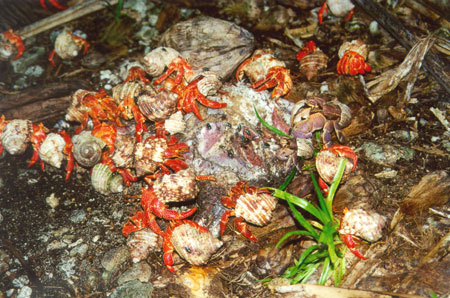 Taphonomy Study
Taphonomy Study A curious anomaly in a 1938 aerial photo of the island
might have been an attempt by the castaway(s) to signal any passing aircraft.
A bare spot in the vegetation nearly fifty feet across appears as an
unnaturally bright white arrowhead-shape a few hundred yards north of
the Seven Site. The feature is not a flaw in the photo and is not present
in later aerial photography, suggesting that it might be man-made, possibly
by bringing white beach sand or coral inland. We’ll locate the spot and see what is there
today.
A curious anomaly in a 1938 aerial photo of the island
might have been an attempt by the castaway(s) to signal any passing aircraft.
A bare spot in the vegetation nearly fifty feet across appears as an
unnaturally bright white arrowhead-shape a few hundred yards north of
the Seven Site. The feature is not a flaw in the photo and is not present
in later aerial photography, suggesting that it might be man-made, possibly
by bringing white beach sand or coral inland. We’ll locate the spot and see what is there
today.